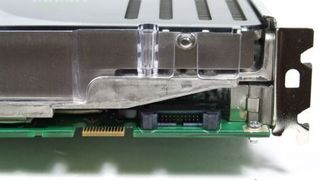Workstation-Shootout: ATi FireGL V7600 vs. Nvidia Quadro FX 4600
Nvidia Quadro FX 4600 - Hardware Details

Nvidia Quadro FX 4600: workstation graphics card with 2 DVI connectors and 1 for stereoscopic glasses.
Until recently, Nvidia enjoyed something of a strategic advantage, having completed the transition to its new generation of workstation parts (based on the G80 chips) much earlier than ATI. In this review, our spotlight is on the Quadro FX 4600, although it, like its Canadian rival, has bigger and smaller siblings. The Quadro FX 5600 is the most expensive member of the family, with the lower end FX 1700, FX 570 and FX 370 models aimed at users with smaller budgets.
With their support for shader model 4.0, all of these cards are up to date; this also includes support for OpenGL 2.1 and DirectX 10 compatibility. Where memory size is concerned, Nvidia's Quadro FX 4600 sounds more attractive than the FireGL V7600 - obviously, 768 MB is more than 256 MB. However, as the benchmarks further on in the review will show, more memory does not necessarily translate into higher performance. The card uses a 384-bit memory interface.
Nvidia now also equips its cards with two dual-link capable DVI connectors. Thus, two monitors with a resolution of 2560 x 1600 each can be used. The FX 4600 is aimed at users in the CAD (computer aided design) and DCC (digital content creation) professions.
The card is capable of rendering 250 million triangles per second, and offers a fill rate of 12 billion texels per second. Its maximum power consumption is 134 watts.

6-Pin Molex connector for auxiliary power on the Quadro FX 4600.

Quadro FX 4600 SLI connector for use with two cards in parallel operation.
Stay on the Cutting Edge
Join the experts who read Tom's Hardware for the inside track on enthusiast PC tech news — and have for over 25 years. We'll send breaking news and in-depth reviews of CPUs, GPUs, AI, maker hardware and more straight to your inbox.
Current page: Nvidia Quadro FX 4600 - Hardware Details
Prev Page ATi FireGL V7600 - Software And Driver Details Next Page Nvidia Quadro FX 4600: Software And Driver Details-
tipoo Is there any reason why these applications couldnt run on a Geforce or Radeon card? Why spring over 1000 bucks for cards with seemingly tame specs?Reply
Most Popular


